Sustainable Development Scenarios in the Danube Delta—A Pilot Methodology for Decision Makers
Abstract
1. Introduction
2. Materials and Methods
- -
- Statistical data from the Romanian National Institute of Statistics:
- Aquaculture, accese: fish consumption;
- Tourism: duration of_tourist staying, the initial duration of stay, initial number of tourists, revenues per tourist day, tourism carrying capacity;
- Agriculture: annual precipitation, crop consumption factor, crop price, ecofarm_fertilizer_use, ecofarm production costs, minimal ecofarm yield, minimal_traditional_farm_yield, traditional crop price.
- -
- Literature overview:
- Aquaculture: aquaculture intensification rate, fish farming labor intensity, fish price, initial area in use for intensive aquaculture, initial area in use for normal aquaculture, intensive aquaculture development rate, intensive aquaculture N load, intensive aquaculture productivity, labor costs per employee, maximum area available for aquaculture, subsidies per unit area;
- Tourism: emergency_level, fraction_of_revenues_used_for_marketing, load_N_per_day, initial marketing budget;
- Agriculture: evaporation, FarmToFork_Target, maximum_area_ecofarms, maximum_N_acceptable_concentration, N_crop_uptake, initial area ecofarms, initial area traditional farms, maximum area ecofarms, maximum fertilizer use, maximum_irrigation, maximum N acceptable concentration, specific crop consumption rate, traditional fertilizer use, traditional farm production costs, traditional intensity.
- -
- Stakeholder expertise:
- Aquaculture: production cost rate for intensive aquaculture, production cost rate for normal aquaculture;
- Tourism: decline rate without development, employment factor, time until emergency level is reached;
- Agriculture: agriculture water demand for 1 hectare, eco-crop price, eco-labor_intensity, specific_crop_consumption_rate, water supply per hectare.
- Aquaculture: aquaculture intensification, Danube N load, effects of pollution on fish farming, fish production ratio, impact of N load aquaculture on water quality, intensive aquaculture development, intensive aquaculture production, intensive fish farm employment, intensive fish farm revenues, intensive fish farm area, normal fish farm employment, normal fish farm revenues, normal fish farm area, spatial pressure from aquaculture development, total aquaculture N load, total aquaculture production, total area in use for aquaculture, total fish farming employment, total fish farming revenues;
- Tourism: impact of marketing on development, impact on N from tourism on water quality, impact pollution on tourism, impact tourism attractiveness on decline, initial tourist days, marketing, number of tourists, tourism attractiveness, tourism decline, tourism development, tourism employment, tourism N load, tourism pressure, tourism revenues;
- Agriculture: eco farm_employment, ecofarm_conversion, ecofarm income, ecofarm productivity, ecofarm transition rate, ecofarms area(t), forest belts installation year, fraction ecofarms, impact of ecofarm fertilizer use on_yield, impact of N from agriculture on water quality, impact of traditional farm fertilizer use on yield, impact of water supply on yield, irrigation, N runoff, number of years forests belts are present, Runoff rate, total agriculture area, total agriculture employment, total agriculture income, total ecofarm productivity, total traditional farm productivity, total fertilizer use, total production, total traditional farm production, traditional farm employment, traditional farm productivity, traditional farms area.
- Stakeholders mapping—The snowball method, which comprises people from initial, smaller, stakeholder groups finding additional contacts and stakeholders, was used for the stakeholders’ identification [18].
- Stakeholders’ meetings—The participatory approach encouraged stakeholder engagement, allowing them to explore their insights and exchange experiences to better understand the behaviour of the ecosystem [18]. Overall, during the meetings, 97 people with expertise in different fields (agriculture, cross-compliance and ecosystem services, coastal and rural tourism, fisheries and aquaculture, blue growth industry, transport, administration, and rural development of the Danube Delta) participated in six sectoral meetings [18]. The participants were locals (village mayors, NGOs, and business owners) but also representatives of the national authorities in the field. We organized six sectoral workshops with the purpose of bringing together domain experts, policymakers, and business entrepreneurs to explore the land–sea interactions from a coastal or rural perspective. They were urged to think about the drivers and impediments to cross-regional and cross-sectoral collaboration. Additionally, both positive and negative externalities were requested of them. We had a candid chat with them while applying systems-thinking conceptualization techniques. During this process, we discovered the key problems, chances, and barriers to sustainable growth as well as cross-sectoral synergies. To accomplish this, methodological coherence was required. To define the initial drivers of the mental modelling exercise flexibly and objectively, a workshop with facilitators from all project study cases was organized. The following is the final list of drivers selected by the experts and used in each workshop: water, human consumption pattern, regulation/policy, temperature, human migration, pollution, and infrastructure [18].
- Causal Loop Diagrams—The main result of the meetings consists of sector-specific shared mental maps of the land–sea system in the Danube Delta [16] collecting all the relevant aspects of the land–sea interactions identified during the discussion by the participants. The results from the individual sectors were afterwards condensed into causal loop diagrams (CLD) both at a sectoral level and as an overall CLD integrating the individual sectors and answering relevant questions such as “which problems and priorities can be defined?”, “who is affected by the problem, and who may be involved in causing it?”, and “is the problem dynamic in nature?” [18,20].
- Business Road Map—The roadmap’s objective is to put out a collection of commercial and policy options that can assist the region in making the transition to a sustainable future cocreated by local stakeholders from a variety of sectors throughout the entire region. The identification of critical locations for intervention within the coastal–rural system and the simulation of various scenarios to arrive at the desired state are both made possible by the coastal–rural system dynamic model. While identifying and proposing solutions involving fishery and aquaculture, agriculture, and tourism, based on local expertise and national to international best practices, scientists and local stakeholders identify the problem [29].
- Model—The CLDs were quantified in a ‘stock-flow’ model, which allows for the examining of the combined impact of reinforcing and balancing feedback mechanisms on the dynamics of the system. The complexity of stock-flow models is in the feedback structure and interactions between variables, which determines the dynamics of the model and hence the way the model responds to policy and business decisions. Thus, the dynamics of conflicts between stakeholders can be analysed to make the best decision appropriate to the proposed goal, the sustainable development of the Danube Delta [30]. The model is organized from a threefold perspective, that integrates three submodels generated by the main problems identified for the economic activities in the region, namely aquaculture, tourism, and agriculture, resulting in time graphs and data showing the dynamics of the problem over time (2050). Each of these three submodels feeds into a master file addressing the socioeconomic development of the area expressed as the rural income and rural workforce. The goal of the model is to explore alternative scenarios of human activity development with the improvement of the quality of life and sustainability within the Danube Delta Biosphere Reserve and its marine waters (Black Sea), as one of the most impacted areas along the Romanian littoral. Therefore, the aquaculture submodel may serve the area’s sustainable development in the future by predicting the beneficial effects of the onset of such economic activity, while also pointing out the possible side effects that should be considered, with the final goal to help the decision-making actors properly design a development strategy for the sector. The rural tourism submodel intends to answer the question of what level of tourism can be developed in the interested area without harming the environment. Finally, the agriculture model’s central point is the potential reduction of the environmental impact of the increasing conversion rate of conventional agriculture to organic farming.
- N crop uptake (tN/tcrop) = (specific crop consumption rate × total agriculture area)/total production
- N runoff (t/y) = Runoff rate*(total fertilizer use-total production*N crop uptake)
- The annual precipitation data (mm/y) were expressed as average precipitation reported for Tulcea region, with a random function between minimum and maximum reported (400,500 mm/year).
- Tourism N load = load N per day*Annual Tourist Days
- Scenarios—From the first project’s meetings on, we wanted to get as close as possible to the stakeholder’s vision on the area of interest, the Danube Delta. Therefore, we asked them what should change over time for improving their activity and everyday life. With their beliefs, we started to draw scenarios, and we used system dynamics modelling to find out the evolution of the variables connected to these scenarios.
- Decisions—The developed model and scenarios represent a dynamic environment for exploring management measures to support the sustainable development of the Danube Delta. This step will be deepened in the Results and Discussions chapters.
3. Results
3.1. Model and Scenarios
3.2. System’s Key Performance Indicators (KPI)
4. Discussion
5. Conclusions
Supplementary Materials
Author Contributions
Funding
Data Availability Statement
Conflicts of Interest
References
- UNESCO. Available online: https://www.unesco.org/en/education/sustainable-development (accessed on 4 July 2022).
- Toprak, Z. Brundtland Report. In Encyclopedia of Corporate Social Responsibility; Idowu, S.O., Capaldi, N., Zu, L., Gupta, A.D., Eds.; Springer: Berlin/Heidelberg, Germany, 2013. [Google Scholar] [CrossRef]
- United Nations. Available online: https://sdgs.un.org/2030agenda (accessed on 4 July 2022).
- Celac, S.; Vadineanu, A. Romania’s SUSTAINABLE DEVELOPMENT Strategy 2030; Editura Paideia: Bucuresti, Romania, 2018; p. 112. [Google Scholar]
- European Environment Agency. Available online: https://www.eea.europa.eu/themes/sustainability-transitions/sustainable-development-goals-and-the/country-profiles/romania-country-profile-sdgs-and (accessed on 6 July 2022).
- Panin, N.; Tiron Duţu, L.; Duţu, F. The Danube Delta—An overview of its Holocene evolution. Mediterranee 2016, 126, 37–54. [Google Scholar] [CrossRef]
- Giosan, L.; Coolen, M.; Kaplan, J.; Constantinescu, S.; Filip, F.; Filipova-Marinova, M.; Kettner, A.J.; Thom, N. Early Anthropogenic Transformation of the Danube-Black Sea System. Sci. Rep. 2012, 2, 582. [Google Scholar] [CrossRef]
- World Bank. Available online: https://www.worldbank.org/content/dam/Worldbank/Feature%20Story/ECA/Romania/Webpage%20-%20Danube%20Delta%20Integrated%20Sustainable%20Development%20Strategy%20NOV-DEC14%20FOR%20PDF.pdf (accessed on 11 July 2022).
- Ministerul Agriculturii si Dezvoltarii Rurale. Available online: https://www.madr.ro/docs/agricultura/strategia-agroalimentara-2020-2030.pdf (accessed on 12 July 2022).
- Programul Operational pentru Pescuit si Afaceri Maritime. Available online: https://www.ampeste.ro/docs/PAP_/PAP_2021-2027/Proiect_PAP_1_feb_2021.pdf (accessed on 12 July 2022).
- World Bank. România, Strategia naţională a României pentru dezvoltarea turismului 2019–2030, VOLUMUL 1: Raport Privind Evaluarea Rapidă a Sectorului Turistic, 2018. Available online: http://b2b-strategy.ro/b2b/wp-content/uploads/Strategia-na%C8%9Bional%C4%83-a-Rom%C3%A2niei-pentru-dezvoltarea-turismului-Volumul-1.pdf (accessed on 6 September 2022).
- World Bank. Strategia de Dezvoltare Turistică a României Volumul 2—Strategia și Planul de Acțiune, 2019. Available online: http://sgg.gov.ro/1/wp-content/uploads/2020/09/Strategia-de-Dezvoltare-Turistic%C4%83-a-Rom%C3%A2niei-volum-2-Strategia-%C8%99i-Planul-de-Ac%C8%9Biune.pdf (accessed on 1 August 2022).
- United Nations. Traffic Congestion the Problem and How to Deal With It; Bull, A., Ed.; United Nations: Santiago, Chile, 2003; pp. 13–18. [Google Scholar]
- ICPDR. River Basin Management Plan for the Danube River Basin District, Further Referred to as Danube River Basin Management Plan (DRBMP), Update 2021; ICPDR—International Commission for the Protection of the Danube River: Vienna, Austria, 2021; p. 290. [Google Scholar]
- Grupul de Actiune Locala Delta Dunarii. STRATEGIA DE DEZVOLTARE LOCALĂ a teritoriului GAL DELTA DUNĂRII din județul TULCEA, 2021. Available online: https://gal-deltadunarii.ro/wp-content/uploads/2022/01/6.-STRATEGIA-DE-DEZVOLTARE-LOCAL%C4%82-aprilie-2021-V7-.pdf (accessed on 4 August 2022).
- Vaidianu, N.; Paraschiv, M.; Saghin, I.; Braghina, C. Social-ecological consequences of planning and development policies in the Danube Delta biosphere reserve, Romania. Carpathian, J. Earth Environ. Sci. 2015, 10, 113–124. [Google Scholar]
- DDBRA. Raportul Privind Starea Mediului în Rezervaţia Biosferei Delta Dunării în Anul 2020. Available online: https://ddbra.ro/wp-content/uploads/2021/10/Starea-Mediului-2020.pdf (accessed on 4 August 2022).
- Tiller, R.; Destouni, G.; Golumbeanu, M.; Kalantari, Z.; Kastanidi, E.; Lazar, L.; Lescot, J.-M.; Maneas, G.; Martínez-López, J.; Notebaert, B.; et al. Understanding Stakeholder Synergies Through System Dynamics: Integrating Multi-Sectoral Stakeholder Narratives Into Quantitative Environmental Models. Front. Sustain. 2021, 2, 701180. [Google Scholar] [CrossRef]
- Sterman, J.D. Business Dynamic Systems Thinking and Modeling for a Complex World; The McGraw-Hill Companies: New York, NY, USA, 2000; p. 981. [Google Scholar]
- Karageorgis, A.; Panagopoulos, Y.; Kastanidi, E.; Destouni, G.; Kalantari, Z.; Seifollahi, S.; Maneas, G.; Lescot, J.-M.; Vernier, F.; Lazar, L.; et al. Deliverable D13 Pilot SD Models for Coastal-Rural Interactions—Case Study Level, 2020. Available online: https://h2020-coastal.eu/assets/content/Deliverables/773782-COASTAL-WP4-D13.pdf (accessed on 3 October 2022).
- Li, F.J.; Dong, S.C.; Li, F. A system dynamics model for analyzing the eco-agriculture system with policy recommendations. Ecol. Model. 2012, 227, 34–45. [Google Scholar] [CrossRef]
- Nguyen, T.; Cook, S.; Ineland, V. Application of System Dynamics to Evaluate the Social and Economic Benefits of Infrastructure Projects. Systems 2017, 5, 29. [Google Scholar] [CrossRef]
- Van den Belt, M. Mediated Modeling: A System Dynamics Approach to Environmental Consensus Building; Island Press: Washington, DC, USA, 2004; p. 328. [Google Scholar]
- Voinov, A. Systems Science and Modeling for Ecological Economics; Elsevier: Amsterdam, The Netherlands, 2008; p. 416. [Google Scholar]
- Amadei, B. A Systems Approach to Modeling Communit Development Projects; Momentum Press Engineering: New York, NY, USA, 2015; p. 295. [Google Scholar]
- Currie, D.J.; Smith, C.; Jagals, P. The application of system dynamics modelling to environmental health decision-making and policy—A scoping review. BMC Public Health 2018, 18, 402. [Google Scholar] [CrossRef]
- Ford, A. Modeling the Environment. An Introduction to System Dynamics Models of Environmental Systems; Island Press: Washington, DC, USA, 1999; p. 401. [Google Scholar]
- EEP, Alterra, Ecologic, PBL and UNEP-WCMC. Scenarios and Models for Exploring Future Trends of Biodiversity and Ecosystem Services Changes; Final report to the European Commission, DG Environment on Contract ENV.G.1/ETU/2008/0090r; Institute for European Environmental Policy, Alterra Wageningen UR, Ecologic, Netherlands Environmental Assessment Agency, United Nations Environment Programme World Conservation Monitoring Centre: Wageningen, The Netherlands, 2009; p. 167. [Google Scholar]
- Guittard, A.; Akinsete, E.; Koundouri, P.; Tiller, R.; Viaene, P. A Systems Approach for the Sustainable Development of Coastal-Rural Regions. Department of International and European economic studies Athens University of Economics and Business Working Paper Series. 2022. Available online: http://wpa.deos.aueb.gr/docs/COASTAL_SystemApproach_OceanCoastalmanagement_Final.pdf (accessed on 16 August 2022).
- EC—EU Strategy for the Danube Region. Available online: https://danube-region.eu/wp-content/uploads/2019/12/EUSDR_Consolidated-Input-Document_AP-Revision_2019.pdf (accessed on 3 August 2022).
- Curtea de Conturi. Performanța Administrării și Exploatării Resurselor Acvatice vii din Habitatele Piscicole Naturale și a Acvaculturii, în Perioada 2016–2019. Available online: https://www.curteadeconturi.ro/uploads/f0298466/9272050b/e2a14f74/4dcddbd7/726d6806/6a5876e0/25c85294/3f685ef9/SINTEZA_Raport_AP_PESCUIT_si_ACVACULTURA_2016-2019.pdf (accessed on 12 July 2022).
- Meadows, D.H.; Randers, J. Limits to Growth; Chelsea Green Publishing: White River Junction, VT, USA, 2013. [Google Scholar]
- Pharino, C.; Sailamai, N.; Kamphaengthong, P.L. Material Flow Analysis of Nitrogen in Maeklong River Basin in Ratcaburi and Samut Songkhram Province, Thailand. Water Conserv. Sci. Eng. 2016, 1, 167–175. [Google Scholar] [CrossRef]
- The Aquaculture Advisory Council. The Provision of Ecosystem Services by European Aquaculture; The Aquaculture Advisory Council: Brussels, Belgium, 2021. [Google Scholar]
- Yeo, S.E.; Binkowski, F.P.; Morris, J.E. Aquaculture Effluents and Waste By-Products Characteristics, Potential Recovery, and Beneficial Reuse; Communications Office UW Sea Grant Institute Goodnight Hall: Madison, Wl, USA, 2004. [Google Scholar]
- Mulder, A. The quest for sustainable nitrogen remo val technologies. Water Sci. Technol. 2003, 48, 67–75. [Google Scholar] [CrossRef]
- Clive, R.G.; Reed, J.B.; Harper, S.J.F.; Kourosh, S.-P.; Deakin, P.J. Essential Surgery: Problems, Diagnosis and Management; Elsevier: Amsterdam, The Netherlands, 2014; p. 673. [Google Scholar]
- Leach, A.M.; Galloway, J.N.; Bleeker, A.; Erisman, J.W.; Kohn, R.; Kitzes, J. A nitrogen footprint model to help consumers understand their role in nitrogen losses to the environment. Environ. Dev. 2012, 1, 40–66. [Google Scholar] [CrossRef]
- Riahi, K.; van Vuuren, D.P.; Kriegler, E.; Edmonds, J.; O’Neill, B.C.; Fujimori, S.; Bauer, N.; Calvin, K.; Dellink, R.; Fricko, O.; et al. The Shared Socioeconomic Pathways and their energy, land use, and greenhouse gas emissions implications: An overview. Glob. Environ. Chang. 2017, 42, 153–168. [Google Scholar] [CrossRef]
- United Nations. Nationally Determined Contributions under the Paris Agreement. Available online: https://unfccc.int/sites/default/files/resource/cma2021_08_adv_1.pdf (accessed on 16 August 2022).
- ICPDR. Revision and Update of The Danube Study “Integrating and Editing New Scientific Results in Climate Change Research and the Resulting Impacts on Water Availability to Revise the Existing Adaptation Strategies in the Danube River Basin”. Available online: https://www.icpdr.org/main/sites/default/files/nodes/documents/danube_climate_adaptation_study_2018.pdf (accessed on 4 July 2022).
- ANPA, Raport de Activitate al Agenției Naționale Pentru Pescuit și Acvacultură in Anul 2021. Available online: http://www.anpa.ro/wp-content/uploads/2022/02/RAPORT-final-de-activitate-ANPA-2021.pdf (accessed on 9 August 2022).
- Roșca, V.; Ignat, R. The sustainability of fish consumption in Romania: Customer behaviour prior and after the country’s adherence to the EU. Amfiteatru Econ. 2014, XVI, 243–257. [Google Scholar]
- Hoekstra, A.; Chapagain, A.K.; Aldaya Mekonnen, M.M. The Water Footprint Assessment Manual; Earthscan: London, UK, 2011; p. 228. [Google Scholar]
- Panin, N. Danube Delta. Genesis, evolution and sedimentology. Révue Roum. Géologie Géophysique Géographie Série Géographie 1989, 33, 25–36. [Google Scholar]
- Giosan, L.; Donnelly, J.; Vespremeanu, E.; Bhattacharya, J.; Olariu, C.; Buonaiuto, F. River delta morphodynamics: Examples from the Danube Delta. River Deltas—Concepts Model. Ex. SEPM Spec. Publ. 2005, 83, 393–411. [Google Scholar]
- Friedrich, J.; Dinkel, C.; Grieder, E.; Radan, S.; Secrieru, D.; Steingruber, S.; Wehrli, B. Nutrient uptake and benthic regeneration in Danube Delta Lakes. Biogeochemistry 2003, 64, 373–398. [Google Scholar] [CrossRef]
- Panin, N.; Overmars, W. The Danube Delta evolution during the Holocene: Reconstruction attempt using geomorphological and geological data, and some of the existing cartographic documents. Geo-Eco-Marina 2012, 18, 75–104. [Google Scholar]
- Cretescu, I.; Kovacs, Z.; Lazar, L.; Burada, A.; Sbarcea, M.; Teodorof, L.; Padure, D.; Soreanu, G. Danube Delta: Water Management on the Sulina Channel in the Frame of Environmental Sustainability. In River Deltas Research—Recent Advances; IntechOpen: Rijeka, Croatia, 2021. [Google Scholar] [CrossRef]
- Gastescu, P. The biodiversity of the Danube Delta Biosphere Reserve reflected in the structure of the ecosystems. In Proceedings of the Water Resources and Wetlands 5th International Hybrid Conference Water Resources and Wetlands, Tulcea, Romania, 8–12 September 2021; p. 235. [Google Scholar]
- Panin, N. The Danube Delta—The mid term of the geo-system Danube river—Danube Delta—Black Sea. Geological setting, sedimentology and holocene to present-day evolution. Rev. Roum. Géologie 2011, 55, 41–82. [Google Scholar]
- Cristofor, S.; Vadineanu, A.; Ignat, G. Importance of flood zones for nitrogen and phosphorus dynamics in the Danube Delta. Hydrobiologia 1993, 251, 143–148. [Google Scholar] [CrossRef]
- Cozzi, S.; Ibáñez, C.; Lazar, L.; Raimbault, P.; Giani, M. Flow Regime and Nutrient-Loading Trends from the Largest South European Watersheds: Implications for the Productivity of Mediterranean and Black Sea’s Coastal Areas. Water 2019, 11, 1. [Google Scholar] [CrossRef]
- Tucker, G.M.; Kettunen, M.; McConville, A.J.; Cottee-Jones, E. Valuing and conserving ecosystem services: A scoping case study in the Danube basin. In Report Prepared for WWF; Institute for European Environmental Policy: London, UK, 2010. [Google Scholar]
- Drost, H.J. Ecological Gradients in the Danube Delta Lakes, 1998. Available online: https://www.researchgate.net/publication/232237509_Ecological_gradients_in_the_Danube_Delta_lakes_Present_state_and_man-induced_changes_Ministry_of_Transport_Public_Works_and_Water_Management (accessed on 5 October 2022).
- Kideys, A.E. Fall and rise of the Black Sea ecosystem. Science 2002, 297, 1482–1483. [Google Scholar] [CrossRef]
- Oguz, T.; Velikova, V. Abrupt transition of the northwestern Black Sea shelf ecosystem from a eutrophic to an alternative pristine state. Mar. Ecol. Prog. Ser. 2010, 405, 231–242. [Google Scholar] [CrossRef]
- Cociasu, A.; Dorogan, L.; Humborg, C.; Popa, L. Long-term ecological changes in Romanian coastal Waters of the Black Sea. Mar. Pollut. Bull. 1996, 32, 32–38. [Google Scholar] [CrossRef]
- Yunev, J.O.A.; Carstensen, J.; Moncheva, S.; Khaliulin, A.; Ærtebjerg, G.; Nixon, S. Nutrient and phytoplankton trends on the western Black Sea shelf in response to cultural eutrophication and climate changes. Estuar. Coast. Shelf Sci. 2007, 74, 63–76. [Google Scholar] [CrossRef]
- Strokal, M.; Kroeze, C. Nitrogen and phosphorus inputs to the Black Sea in 1970–2050. Reg. Environ. Chang. 2013, 13, 179–192. [Google Scholar] [CrossRef]
- ICPDR. Danube Watch, 2015. Available online: https://www.icpdr.org/main/publications/nitrogen-pollution-danube-basin (accessed on 6 October 2022).
- ICPDR. Available online: https://www.icpdr.org/main/issues/phosphorus (accessed on 6 October 2022).
- Collste, D.; Pedercini, M.; Cornell, S.E. Policy coherence to achieve the SDGs: Using integrated simulation models to assess effective policies. Sustain. Sci. 2017, 12, 921–931. [Google Scholar] [CrossRef]
- Baboianu, G. Danube Delta: The Transboundary Wetlands (Romania and Ukraine). In The Wetland Book II: Distribution, Description, and Conservation; Springer: Dordrecht, The Netherlands, 2016. [Google Scholar]
- Petrişor, A.-I. Assessment of the long-term effects of global changes within the Romanian natural protected areas. Int. J. Conserv. Sci. 2016, 7, 759–770. [Google Scholar]
- Sbarcea, M.; Petrişor, A.-I.; Petrişor, L.-E. Mapping Potential Environmental Conflicts in the Danube Delta Biosphere Reserve. Sci. Ann. Danub. Delta Inst. 2019, 24, 175–182. [Google Scholar]


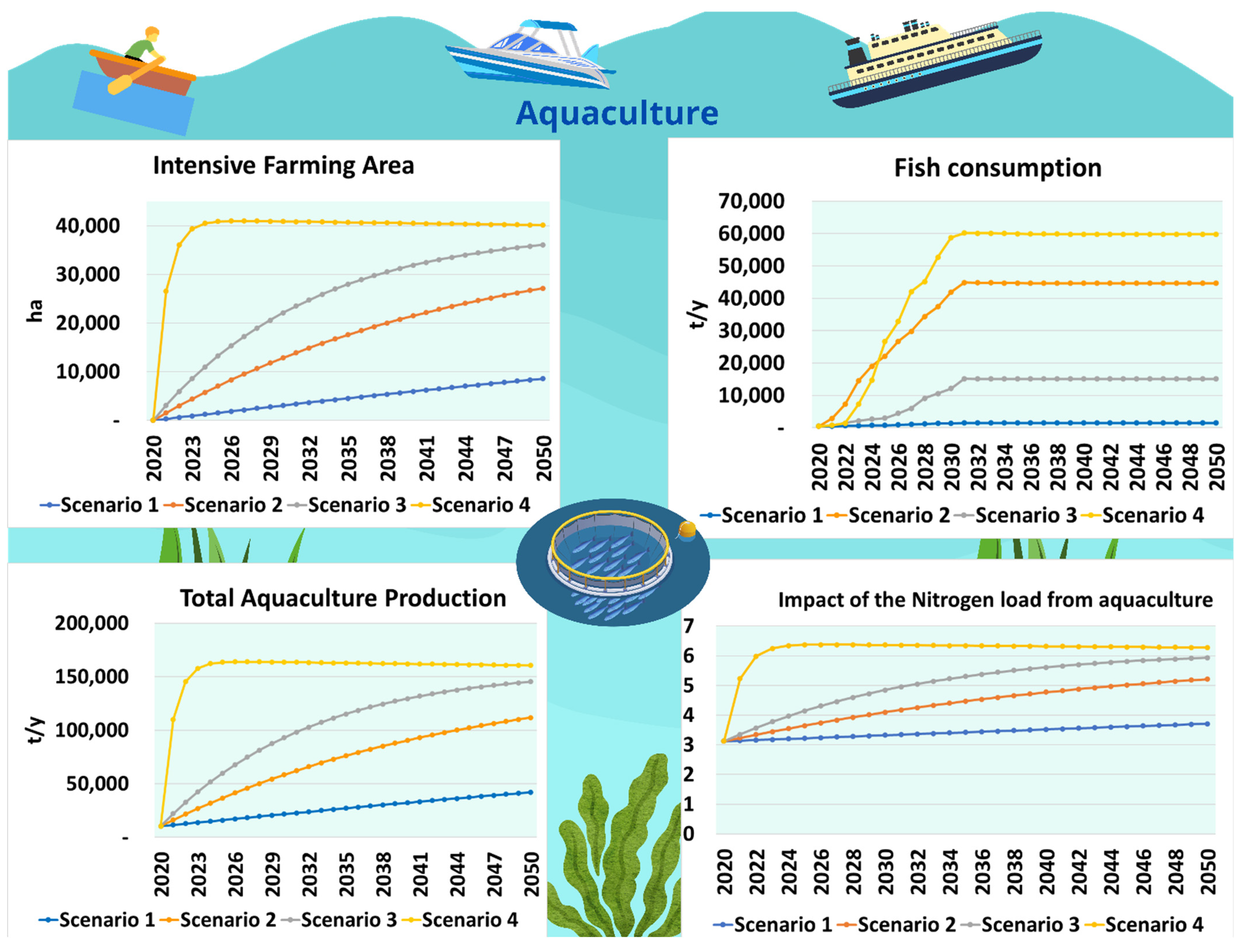
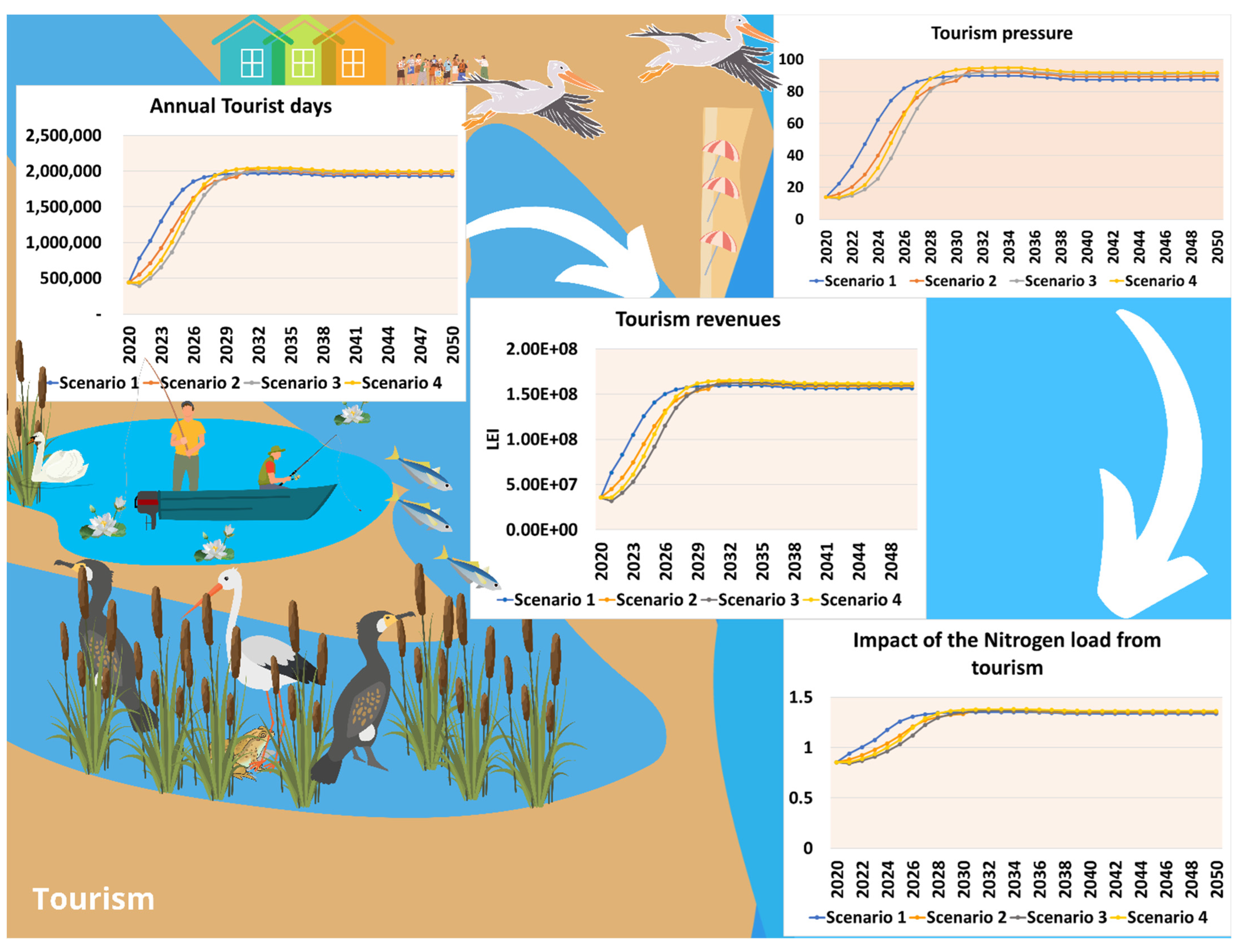
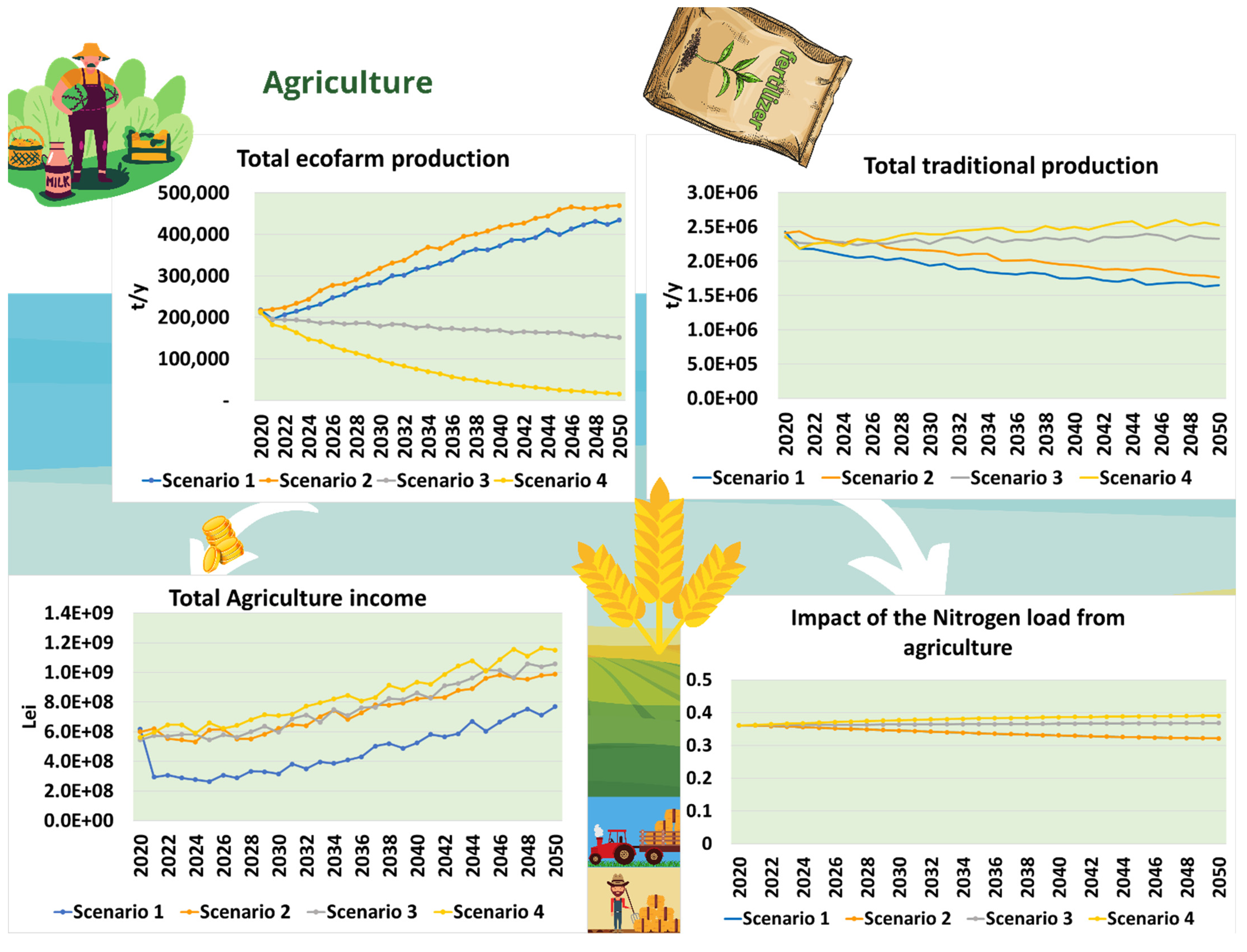
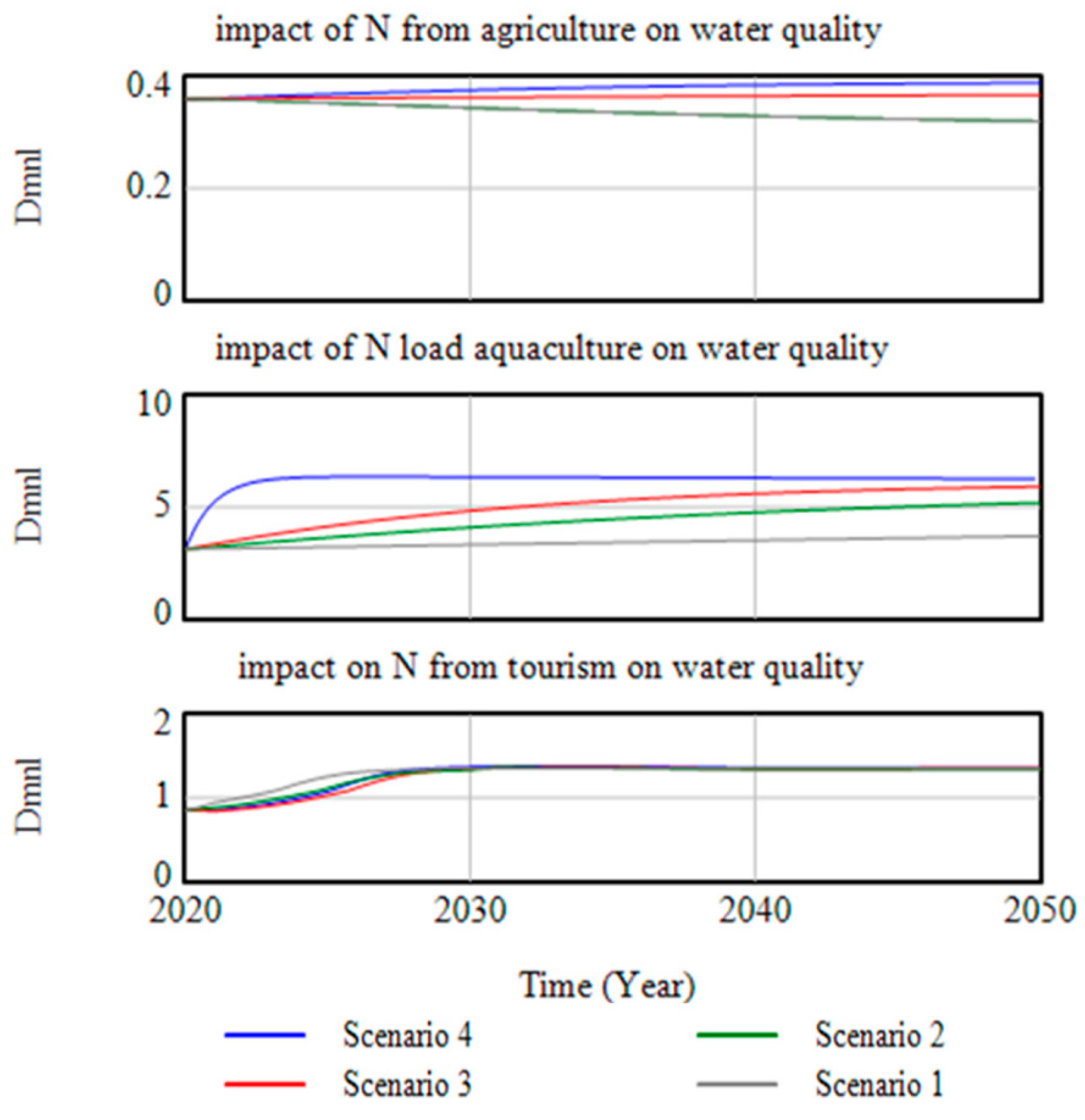
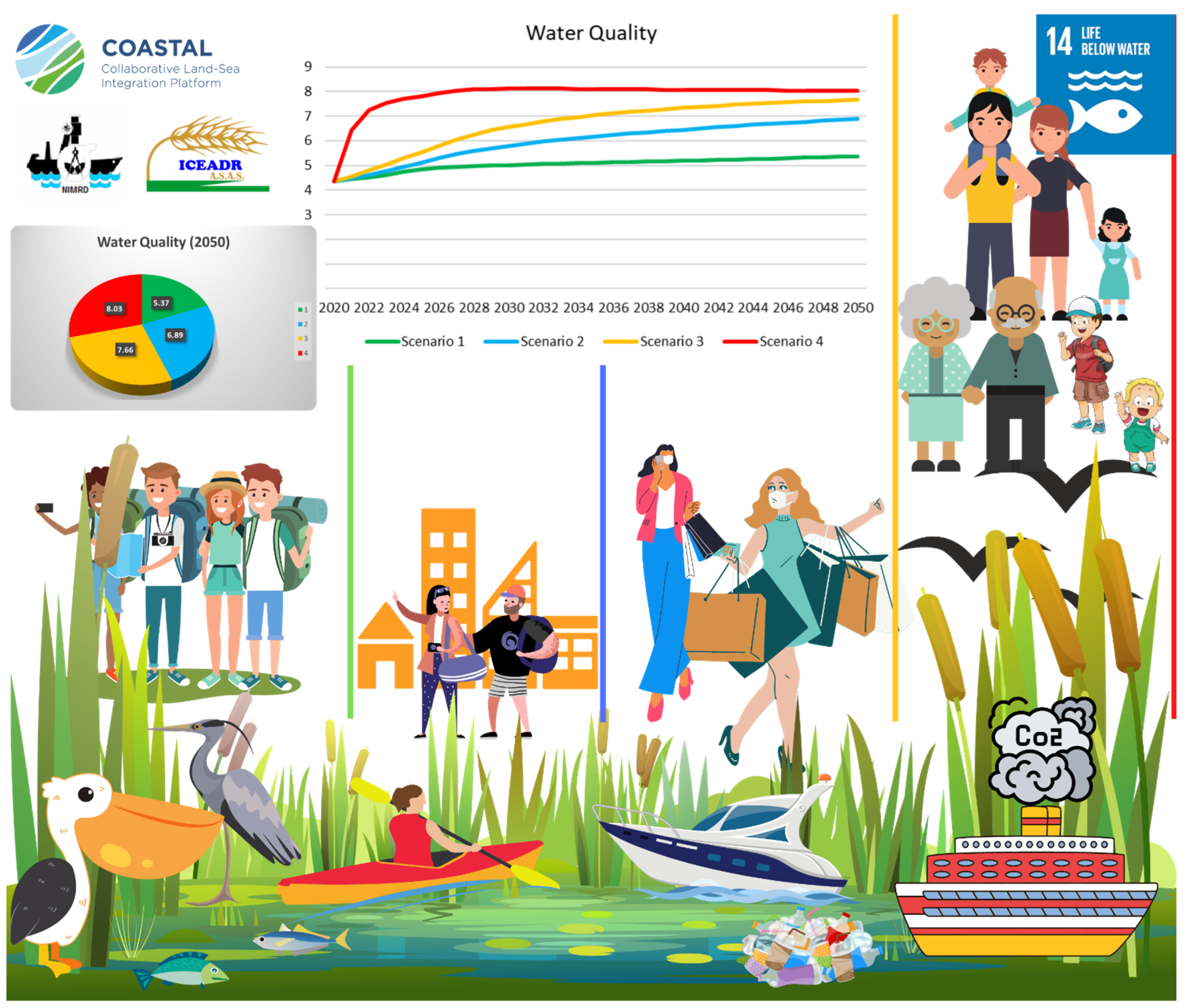
| No. | Model Input Variable | System-External Uncertainties Affecting This Model Input Variable |
|---|---|---|
| 1 | Eco crop costs | Population growth; urbanization level; urbanization type; land use |
| 2 | Farm to Fork target | Urbanization level; policy orientation; environment; land use; agriculture |
| 3 | Crop farm costs | Population growth; urbanization type; consumption; environmental policy; technology transfer |
| 4 | Maximum fertilizer use (K) | Policy orientation; agriculture productivity |
| 4 | Danube’s flow | Climate change RCP 1.5 |
| 5 | Annual precipitation | Climate change RCP 1.5 |
| 6 | Evaporation | Climate change RCP 1.5 |
| 7 | Fish consumption | Population growth; governance |
| 8 | Fish price | Development of the area; governance |
| 9 | Labour costs per employee | Development of the area; governance |
| 10 | Aquaculture intensification rate | Development of the area; technology; land use |
| 11 | Duration of tourist day | Economic growth; tourism; development of the area |
| 12 | Revenues per tourist day | Economic growth; tourism; development of the area |
| Variable | Scenario 1 | Scenario 2 | Scenario 3 | Scenario 4 | KPI (Results of the Model) |
|---|---|---|---|---|---|
| Aquaculture | |||||
| Fish consumption factor | +10% | +300% | +100% | +400% | 1. Intensive fish farming area 2. Total aquaculture production 3. Fish consumption 4. Impact of nitrogen load from aquaculture |
| Fish price | +20% | +25% | +5% | +5% | |
| Labour costs | +2.4% | +2.4% | +3.1% | +10% | |
| Aquaculture intensification rate | 0.01 | 0.04 | 0.08 | 1 | |
| Tourism | |||||
| Duration of tourist stay | +36% | +30% | −30% | −22% | 5. Annual tourist days 6. Tourism revenues 7. Tourism pressure 8. Impact of nitrogen load from tourism |
| Revenues per tourist | +17% | −13% | +60% | +10% | |
| Agriculture | |||||
| Ecocrop cost | −10% | 0% | +10% | +20% | 9. Ecofarm production 10. Traditional farm production 11. Total agriculture income 12. Fraction ecofarms 13. Impact of nitrogen load from agriculture |
| Crop farm cost | +10% | 0% | −10% | −20% | |
| Farm to Fork | +30% | 0% | +15% | −8% | |
| Max fertilizer use | −5% | 0% | +10% | +20% | |
| Climate change | |||||
| Danube flow | −10% | −10% | −10% | −10% | |
| Evaporation | +3% | +3% | +3% | +3% | |
| Precipitation | −10% | −10% | −10% | −10% | |
Publisher’s Note: MDPI stays neutral with regard to jurisdictional claims in published maps and institutional affiliations. |
© 2022 by the authors. Licensee MDPI, Basel, Switzerland. This article is an open access article distributed under the terms and conditions of the Creative Commons Attribution (CC BY) license (https://creativecommons.org/licenses/by/4.0/).
Share and Cite
Lazar, L.; Rodino, S.; Pop, R.; Tiller, R.; D’Haese, N.; Viaene, P.; De Kok, J.-L. Sustainable Development Scenarios in the Danube Delta—A Pilot Methodology for Decision Makers. Water 2022, 14, 3484. https://doi.org/10.3390/w14213484
Lazar L, Rodino S, Pop R, Tiller R, D’Haese N, Viaene P, De Kok J-L. Sustainable Development Scenarios in the Danube Delta—A Pilot Methodology for Decision Makers. Water. 2022; 14(21):3484. https://doi.org/10.3390/w14213484
Chicago/Turabian StyleLazar, Luminita, Steliana Rodino, Ruxandra Pop, Rachel Tiller, Nele D’Haese, Peter Viaene, and Jean-Luc De Kok. 2022. "Sustainable Development Scenarios in the Danube Delta—A Pilot Methodology for Decision Makers" Water 14, no. 21: 3484. https://doi.org/10.3390/w14213484
APA StyleLazar, L., Rodino, S., Pop, R., Tiller, R., D’Haese, N., Viaene, P., & De Kok, J.-L. (2022). Sustainable Development Scenarios in the Danube Delta—A Pilot Methodology for Decision Makers. Water, 14(21), 3484. https://doi.org/10.3390/w14213484









